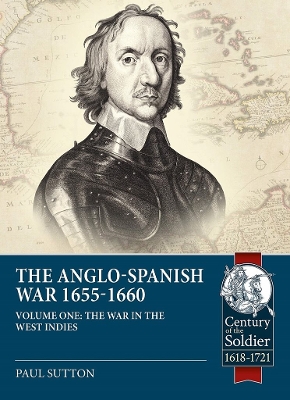Century of the Soldier
2 total works
In 1655 Oliver Cromwell, England's Lord Protector, sent a fleet to attack and seize Spanish possessions in South America. The English was flexing its muscles on the international stage and for political, religious and commercial reasons chose to attacked a weakened Spain in the West Indies believing it a soft target. In late 1654 possibly the largest military force to date ever to leave English shores set sail from Portsmouth under the command of General Robert Venables and Admiral William Penn.
This book describes the reasons for war with Spain, the army and fleet assembled at Cromwell's bidding and its objective. The attack on Hispaniola in April 1655 will be explained in detail along with the reasons for its failure as will the occupation of Jamaica as will the beginnings of the Spanish war of resistance. A subsequent volume will recount the war on Jamaica from the end of 1655 until 1660.
This work draws upon extensive primary source material from England and Spain as well as the copious amounts of letters and narratives of soldiers and sailors present, from both sides.
This book describes the reasons for war with Spain, the army and fleet assembled at Cromwell's bidding and its objective. The attack on Hispaniola in April 1655 will be explained in detail along with the reasons for its failure as will the occupation of Jamaica as will the beginnings of the Spanish war of resistance. A subsequent volume will recount the war on Jamaica from the end of 1655 until 1660.
This work draws upon extensive primary source material from England and Spain as well as the copious amounts of letters and narratives of soldiers and sailors present, from both sides.
In 1655 Oliver Cromwell, England's Lord Protector, sent a fleet to attack and seize Spanish possessions in South America. After initial failure on Hispaniola the English occupied Jamaica and in so doing started a five year war with Spain in the West Indies, but one that was also to spread to Europe. This is the second of a two book series that describes the military campaign from late 1655 until 1660. It also puts the events that occurred in the West Indies into context with the wider European political situation and explains how the war spread to Europe.
Utilising numerous English and Spanish sources the early years of the Jamaican colony are described in detail, whilst extensive previously unpublished Spanish maps of the island are reproduced . The book charts the course of the Spanish resistance and how challenging they were to English settlement but it also illustrates the division between the fractious Spanish government. Under the indomitable leadership of Edward Doyley the English faced high mortality from disease and famine along with Spanish invasion attempts but persevered to establish the jewel in the crown of the British colonial possessions in the Caribbean. The changing nature of the English forces are examined, as is the development of the nascent economy developed as are the roles that privateering and slavery played in this development. The book concludes with the transition from a Commonwealth to a Crown colony and the advent of civilian rule. Appendices also describe the occupation by the English of both Tortuga and the Cayman Islands as they gradually expanded the empire in the northern Caribbean.
Utilising numerous English and Spanish sources the early years of the Jamaican colony are described in detail, whilst extensive previously unpublished Spanish maps of the island are reproduced . The book charts the course of the Spanish resistance and how challenging they were to English settlement but it also illustrates the division between the fractious Spanish government. Under the indomitable leadership of Edward Doyley the English faced high mortality from disease and famine along with Spanish invasion attempts but persevered to establish the jewel in the crown of the British colonial possessions in the Caribbean. The changing nature of the English forces are examined, as is the development of the nascent economy developed as are the roles that privateering and slavery played in this development. The book concludes with the transition from a Commonwealth to a Crown colony and the advent of civilian rule. Appendices also describe the occupation by the English of both Tortuga and the Cayman Islands as they gradually expanded the empire in the northern Caribbean.

